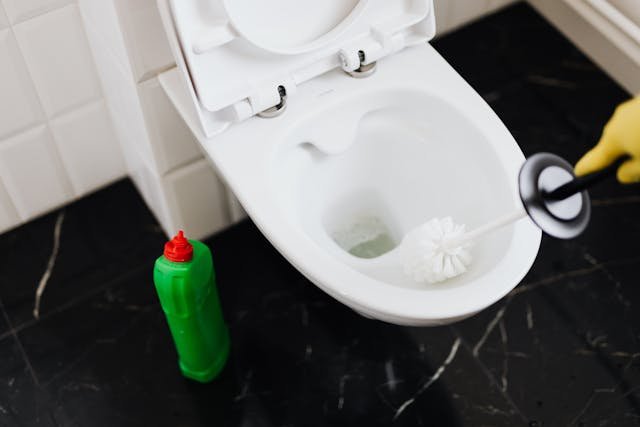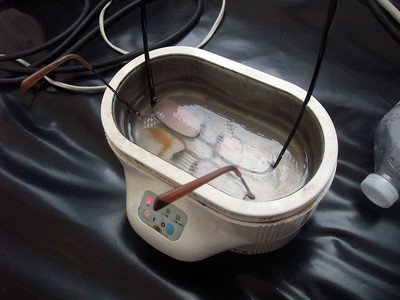Many of us clean our toilets reluctantly, but it is an essential chore. Nevertheless, the effort is worth it, if you can see a spotless, fresh smelling toilet.
Now, when normal cleansers fail, acids come to the rescue easily breaking down even the hardest stains and mineral deposits. So which acid is best for cleaning toilets? We’ll go into detail on the options, including how effective they are, where to use them, how safe they are, and best practices.
Why Acids Are Used for Toilet Cleaning?

There are all kinds of stubborn stains that can be found in toilets—hard water rings, rust marks, and just plain grime that won’t come off with regular scrubbing. Acids are potent cleaning chemicals that chemically remove these residues, so conserving time and effort. Acids come in the form of professional cleaning products, as well as natural solutions. While all of them can be useful, if you don’t know what you are doing and how to use them correctly, they are far more harmful than good.
1. Hydrochloric Acid (HCl) – The Heavyweight Champion
The big gun in the toilet-cleaning arsenal is hydrochloric acid. It’s known for its strength and is often the main ingredient in many commercial toilet cleaners. It is aggressive to calcium carbonate and iron oxide and will dissolve hard water stains and rust.
How It Works
When applied, hydrochloric acid dissolves mineral deposits and rust via a chemical process that converts these minerals into water-soluble molecules. It’s quick, with visible improvement in a few minutes.
How to Use Hydrochloric Acid for Toilets
- Dilute one part hydrochloric acid with ten parts water in a plastic container and begin the cleaning process.
- Spend a bit more time and slowly pour the solution around the rim of toilet bowl making sure all stained areas are covered.
- Leave it on for 10–15 minutes to soak the stains.
- Scrub with a toilet brush; pay closer attention to areas you have trouble with.
- Rinse thoroughly to wash off the residue.
Effectiveness
Pros: It removes even the toughest hard water stains, rust and grime in minimum time.
Cons: It’s highly corrosive, and can erode the protective glaze on porcelain if used too often.
Safety Precautions
Strong fumes of hydrochloric acid can irritate your lungs, so work in a well ventilated area. Gloves, goggles and a mask are worn and contact with skin and eyes is avoided.
2. Muriatic Acid – The Industrial-Grade Alternative
Muriatic acid is basically diluted hydrochloric acid sold for industrial cleaning. It’s a go to solution for the most stubborn stains and buildup, that no other acid can handle.
How It Works
Muriatic acid, is like hydrochloric acid, dissolves mineral deposits and rust by the reaction of compounds in them. It’s especially good for toilets that haven’t been cleaned for a long time or that are exposed to hard water.
How to Use Muriatic Acid
- Mix one part muriatic acid and 10 parts of water.
- Pour the mixture into the toilet bowl, carefully, so it doesn’t splash anywhere else.
- Let it sit for 5–10 minutes, but not too long, to prevent damage.
- Scrub, and flush many times to get all of the acid rinsed away.
Effectiveness
Pros: For extreme cases of mineral buildup and rust, this acid is incredibly powerful.
Cons: Porcelain, pipes and even tiles can be damaged if overused or if improperly handled.
Safety Precautions
It’s best to use muriatic acid as a last resort (because of its strength). Handle this with extreme care according to the instructions given by the manufacturer. Use it only after keeping the children and pets away from the area.
3. Citric Acid – The Gentle, Eco-Friendly Option
If you prefer a natural, less abrasive solution, citric acid is the way to go. Derived from fruits like lemons, it’s a safe and eco-friendly alternative to maintain toilet cleanliness .
How It Works
Hard water contains calcium and magnesium which react mildly with citric acid, breaking down these deposits over time. It also has mild antibacterial properties, and is good for more routine cleaning.
Citric Acid for Toilets
- Add 3–4 tablespoons of citric acid powder into a cup of warm water and dissolve.
- Add to the toilet bowl focusing on dirty areas FIRST.
- Leave it overnight for best results.
- In the morning, gently scrub; then, flush to expose a toilet that is brilliantly clean.
Effectiveness
Pros: Eco friendly, safe for daily or weekly use, effective for mild stains and mineral deposits.
Cons: Too weak to fight off deeply ingrained rust or too heavy hard water stains.
Safety Precautions
Citric acid is gentle but it’s still acidic, so wear gloves to protect your skin. Do not mix it with other cleaners.
4. Sulfuric Acid – The Drain Cleaner’s Ally
Most often used in drain cleaners, sulfuric acid is used in order to dissolve organic matter and severe blockages. It’s incredibly potent, but it’s not a great choice for cleaning toilets (because it’s so aggressive).
How It Works
Organic materials, mineral deposits react violently with sulfuric acid which breaks them down rapidly. But if you don’t use it carefully it can also eat away your toilet’s porcelain and internal components.
How to Use Sulfuric Acid (With Caution)
- Use sulfuric acid only if the toilet has full buildup or clogs.
- Do exactly what the manufacturer says.
- Carefully pour it and make it sit for the suggested time.
- As plenty of fumes are generated by this, it is advised to flush everything properly and ventilate the room to disperse fumes.
Effectiveness
Pros: Incredibly effective for tackling the toughest cleaning challenges.
Cons: It can damage plumbing and porcelain, and it emits dangerous fumes.
Safety Precautions
Sulfuric acid is a very hazardous strong acid and should only be used by experienced strong chemical handlers.
5. Oxalic Acid – The Rust Stain Specialist
It’s a great solution for removing rust stains and light mineral buildup. It’s not as aggressive as hydrochloric acid, but it’s still good for some cleaning tasks.
How It Works
Rust is the end product of iron compounds forming with oxygen (oxygen from the air) which is also what causes the red color, but the binding of oxalic acid with iron in those compounds dissolves them into water soluble particles that can be easily scrubbed away.
Oxalic Acid for Toilets: How to Use It
- Make a paste by mixing oxalic acid powder with water.
- Simply apply the paste on rust stains.
- It should sit for 10–20 minutes for the acid to work.
- Then scrub the stains away and rinse thoroughly.
Effectiveness
Pros: Excellent for rust and mild mineral deposits. Less corrosive than stronger acids.
Cons: Little effectiveness on severe hard water stains.
Safety Precautions
Always wear gloves and a mask and avoid coming into direct contact with the powder, or inhaling it.
Final Verdict: Which Acid is Best?
The most effective is hydrochloric acid, if you’re dealing with severe stains and need fast results. Oxalic acid is your friend for rust specific issues. Citric acid wins the day for eco-conscious cleaning or routine maintenance. Heavy duty options are muriatic acid and sulfuric acid that should only be used sparingly and with great care.
A Word of Caution
It’s important to use acids safely. Don’t mix acids with other cleaning products such as bleach if you want to avoid releasing toxic gas. Work always in a well ventilated space, wear protective gear and follow the manufacturer’s instructions.
Conclusion
Cleaning toilets isn’t anyone’s favorite task, but with the right acid, it doesn’t have to be difficult. If you choose the right solution for your needs, and take care of it properly, you can have a sparkling clean toilet without causing yourself unnecessary stress. Whether you’re tackling hard water stains or routine cleaning, there’s an acid that fits the job perfectly.



